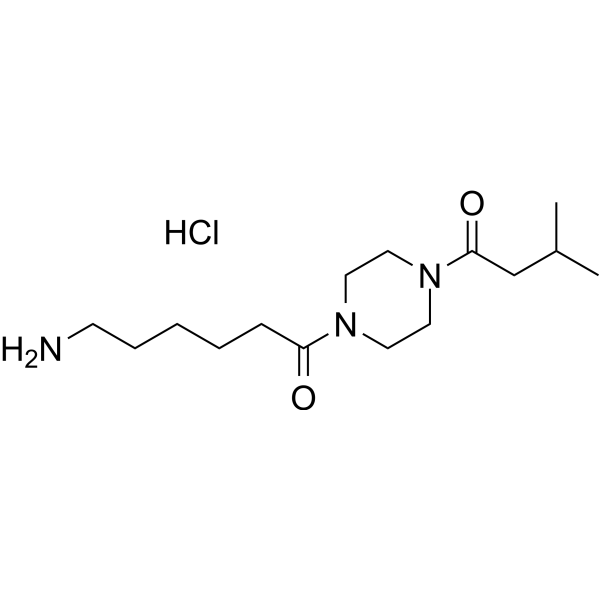Physicochemical Properties
| Molecular Formula | C15H30CLN3O2 |
| Molecular Weight | 319.870603084564 |
| Exact Mass | 319.202 |
| CAS # | 2703451-51-6 |
| Related CAS # | ENMD-1068 hydrobromide;644961-61-5;ENMD-1068;789488-77-3 |
| PubChem CID | 145711518 |
| Appearance | White to off-white solid powder |
| Hydrogen Bond Donor Count | 2 |
| Hydrogen Bond Acceptor Count | 3 |
| Rotatable Bond Count | 7 |
| Heavy Atom Count | 21 |
| Complexity | 310 |
| Defined Atom Stereocenter Count | 0 |
| SMILES | Cl.O=C(CCCCCN)N1CCN(C(CC(C)C)=O)CC1 |
| InChi Key | UDMQQSSIEIJEHG-UHFFFAOYSA-N |
| InChi Code | InChI=1S/C15H29N3O2.ClH/c1-13(2)12-15(20)18-10-8-17(9-11-18)14(19)6-4-3-5-7-16;/h13H,3-12,16H2,1-2H3;1H |
| Chemical Name | 6-amino-1-[4-(3-methylbutanoyl)piperazin-1-yl]hexan-1-one;hydrochloride |
| HS Tariff Code | 2934.99.9001 |
| Storage |
Powder-20°C 3 years 4°C 2 years In solvent -80°C 6 months -20°C 1 month Note: Please store this product in a sealed and protected environment (e.g. under nitrogen), avoid exposure to moisture. |
| Shipping Condition | Room temperature (This product is stable at ambient temperature for a few days during ordinary shipping and time spent in Customs) |
Biological Activity
| Targets | PAR2 |
| ln Vitro | In primary mouse HSCs, ENMD-1068 (10 mM; 24 h) inhibits TGF-β1/Smad signaling (the TGF-β1/Smad signal pathway is essential for HSC activation and collagen production)[1]. Inhibiting trypsin or SLIGRL-NH2 induced calcium release in HSCs is the effect of ENMD-1068 (10 mM; 24 h)[1]. |
| ln Vivo | ENMD-1068 (i.p.; 25–50 mg/kg; twice weekly for 4 weeks) prevents mice's liver fibrosis[1]. In a dose-dependent way, ENMD-1068 (25, 50 mg/kg; ip; once daily for 5 days) reduces the progression of endometriosis and decreases the levels of IL-6 and MCP-1[2]. In mice, ENMD-1068 (25, 50 mg/kg; ip; once daily for 5 days) reduces the proliferation of epithelial cells and raises the apoptotic index[2]. |
| Cell Assay |
Western Blot Analysis[1] Cell Types: Hepatic stellate cells (HSCs) (TGF-β1-stimulated) Tested Concentrations: 10 mM Incubation Duration: 24 h Experimental Results: Inhibited TGF-β1-induced expression of α-SMA, Col α1(І),Col α1(III), and Smad2/ 3 C-terminal phosphorylation. |
| Animal Protocol |
Animal/Disease Models: ICR mice (8weeks old; CCl4-induced liver fibrosis model)[1]. Doses: 25, 50 mg/kg Route of Administration: intraperitoneal (ip)injection; twice per week for 4 weeks Experimental Results: Markedly attenuated collagen deposition. Animal/Disease Models: Mice with surgically induced endometriosis[2]. Doses: 25, 50 mg/kg Route of Administration: intraperitoneal (ip)injection; single daily for 5 days Experimental Results: diminished the volume of observed lesions in a dose-dependent manner. Inhibited the expression of IL-6 and MCP-1. diminished the proliferation rate of endometriotic cells and increased the percentage of apoptotic epithelial cells in the lesions. |
| References |
[1]. ENMD-1068 inhibits liver fibrosis through attenuation of TGF-β1/Smad2/3 signaling in mice. Sci Rep. 2017 Jul 14;7(1):5498. doi: 10.1038/s41598-017-05190-7. Erratum in: Sci Rep. 2019 Dec 10;9(1):19125. [2]. ENMD-1068, a protease-activated receptor 2 antagonist, inhibits the development of endometriosis in a mouse model. Am J Obstet Gynecol. 2014 Jun;210(6):531.e1-8. |
Solubility Data
| Solubility (In Vitro) |
DMSO : 200 mg/mL (625.25 mM) H2O : 100 mg/mL (312.63 mM) |
| Solubility (In Vivo) |
Solubility in Formulation 1: 5 mg/mL (15.63 mM) in 10% DMSO + 40% PEG300 + 5% Tween80 + 45% Saline (add these co-solvents sequentially from left to right, and one by one), suspension solution; with sonication. For example, if 1 mL of working solution is to be prepared, you can add 100 μL of 50.0 mg/mL clear DMSO stock solution to 400 μL PEG300 and mix evenly; then add 50 μL Tween-80 to the above solution and mix evenly; then add 450 μL normal saline to adjust the volume to 1 mL. Preparation of saline: Dissolve 0.9 g of sodium chloride in 100 mL ddH₂ O to obtain a clear solution. Solubility in Formulation 2: ≥ 5 mg/mL (15.63 mM) (saturation unknown) in 10% DMSO + 90% (20% SBE-β-CD in Saline) (add these co-solvents sequentially from left to right, and one by one), clear solution. For example, if 1 mL of working solution is to be prepared, you can add 100 μL of 50.0 mg/mL clear DMSO stock solution to 900 μL of 20% SBE-β-CD physiological saline solution and mix evenly. Preparation of 20% SBE-β-CD in Saline (4°C,1 week): Dissolve 2 g SBE-β-CD in 10 mL saline to obtain a clear solution. Solubility in Formulation 3: ≥ 5 mg/mL (15.63 mM) (saturation unknown) in 10% DMSO + 90% Corn Oil (add these co-solvents sequentially from left to right, and one by one), clear solution. For example, if 1 mL of working solution is to be prepared, you can add 100 μL of 50.0 mg/mL clear DMSO stock solution to 900 μL of corn oil and mix evenly. Solubility in Formulation 4: 100 mg/mL (312.63 mM) in PBS (add these co-solvents sequentially from left to right, and one by one), clear solution; with ultrasonication. (Please use freshly prepared in vivo formulations for optimal results.) |
| Preparing Stock Solutions | 1 mg | 5 mg | 10 mg | |
| 1 mM | 3.1263 mL | 15.6314 mL | 31.2627 mL | |
| 5 mM | 0.6253 mL | 3.1263 mL | 6.2525 mL | |
| 10 mM | 0.3126 mL | 1.5631 mL | 3.1263 mL |
